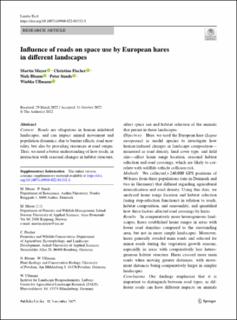Influence of roads on space use by European hares in different landscapes
Peer reviewed, Journal article
Published version
Permanent lenke
https://hdl.handle.net/11250/3043593Utgivelsesdato
2022Metadata
Vis full innførselSamlinger
Sammendrag
Context Roads are ubiquitous in human inhabited landscapes, and can impact animal movement and population dynamics, due to barrier effects, road mortality, but also by providing resources at road verges. Thus, we need a better understanding of how roads, in interaction with seasonal changes in habitat structure, affect space use and habitat selection of the animals that persist in these landscapes. Objectives Here, we used the European hare (Lepus europaeus) as model species to investigate how human-induced changes in landscape composition—measured as road density, land cover type, and field size—affect home range location, seasonal habitat selection and road crossings, which are likely to correlate with wildlife-vehicle collision risk. Methods We collected > 240,000 GPS positions of 90 hares from three populations (one in Denmark and two in Germany) that differed regarding agricultural intensification and road density. Using this data, we analyzed home range location and habitat selection (using step-selection functions) in relation to roads, habitat composition, and seasonality, and quantified how these factors affected road crossings by hares. Results In comparatively more heterogeneous landscapes, hares established home ranges in areas with lower road densities compared to the surrounding area, but not in more simple landscapes. Moreover, hares generally avoided main roads and selected for minor roads during the vegetation growth seasons, especially in areas with comparatively less heterogeneous habitat structure. Hares crossed more main roads when moving greater distances, with movement distances being comparatively larger in simpler landscapes. Conclusions Our findings emphasize that it is important to distinguish between road types, as different roads can have different impacts on animals (e.g., small roads providing foraging opportunities via roadside vegetation and large roads being avoided). Moreover, animals in comparatively more heterogeneous landscapes are better able to adjust their habitat selection to avoid main roads than animals inhabiting simpler landscapes. More generally, homogenous landscapes increase the space use requirements of animals, leading to increased probability of road crossings, which in turn might affect population dynamics via increased road mortality risk.
Beskrivelse
© The Author(s) 2022

